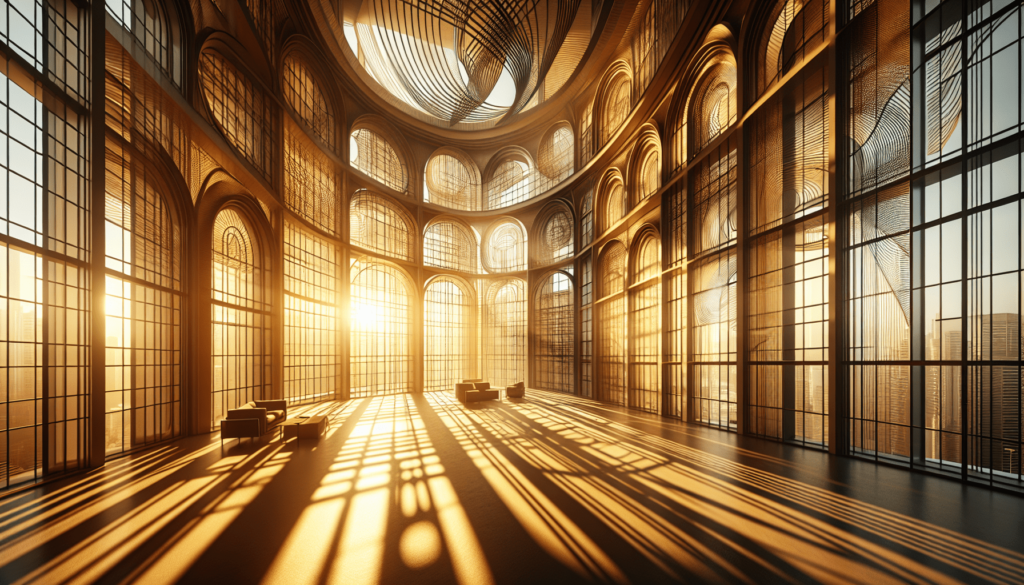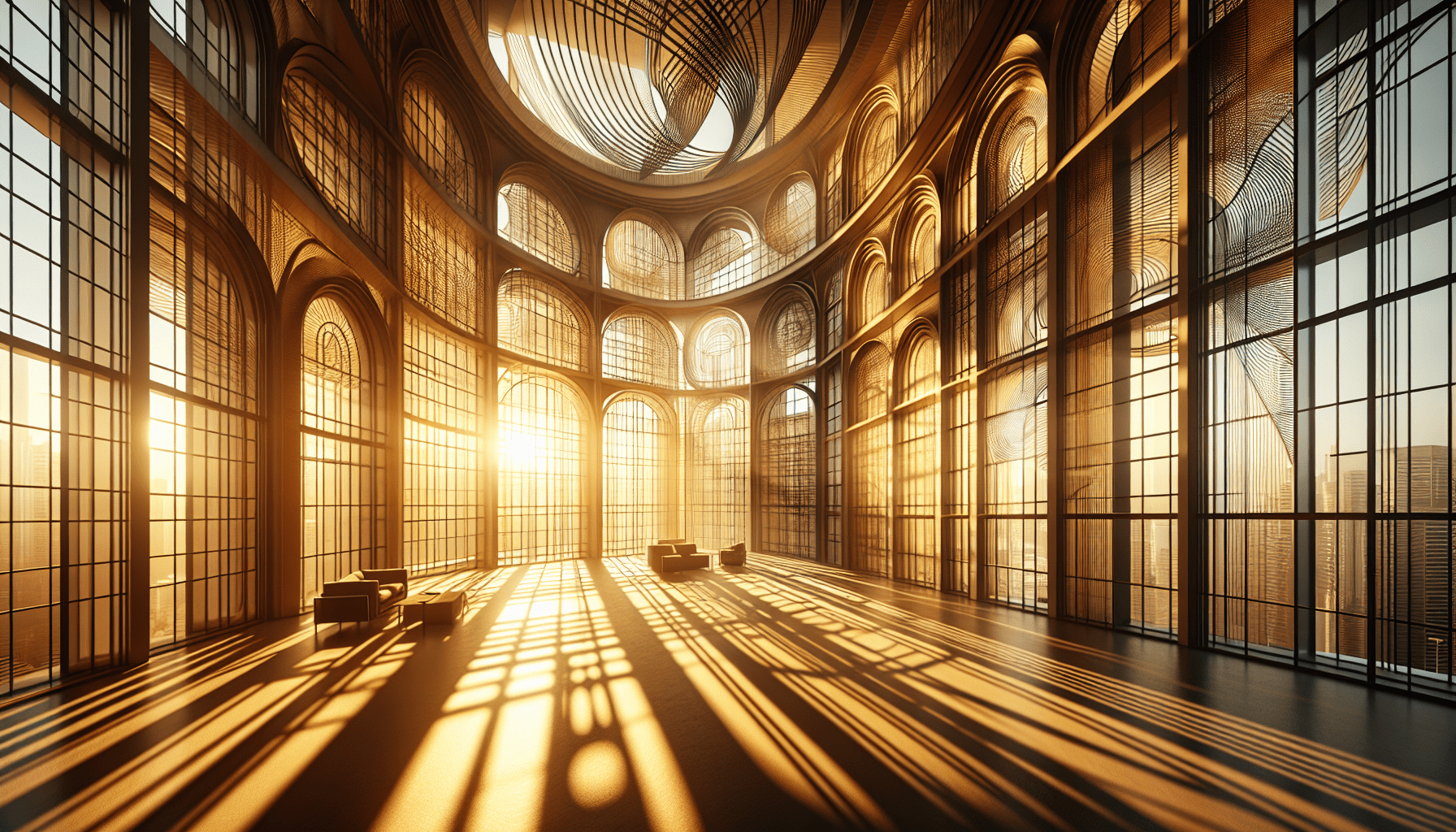Imagine walking into a building flooded with natural light, where the sun’s rays gently dance on the floors and the walls seem to glow. It’s not just aesthetically pleasing, but it also has a profound impact on your well-being. Natural light in buildings has a multitude of benefits, ranging from improving mood and productivity to reducing energy costs. In this article, we will explore the captivating advantages of incorporating natural light into our built environments and how it can positively influence our lives.
Improved Mood and Well-being
Increased serotonin levels
Natural light has been found to have a direct impact on our mood and well-being. One of the ways it achieves this is by increasing serotonin levels in the brain. Serotonin, often referred to as the “feel-good” hormone, plays a crucial role in regulating our emotions and boosting our overall happiness. When you are exposed to natural light, especially in the morning, it triggers the production of serotonin, leading to improved mood and a sense of well-being.
Reduced seasonal affective disorder (SAD)
Many people experience seasonal affective disorder (SAD) during the darker months of the year. This condition is characterized by feelings of depression, lethargy, and a lack of motivation. Natural light can be a powerful remedy for SAD, as it helps regulate our internal body clock and maintain a healthy circadian rhythm. By increasing the amount of natural light in your environment, you can reduce the symptoms of SAD and restore a sense of balance to your emotional well-being.
Elevated mood and enhanced productivity
Spending time in spaces filled with natural light can significantly elevate your mood and enhance productivity. Natural light stimulates the release of endorphins, which are natural mood enhancers. These endorphins can boost your overall sense of happiness and motivation, making you feel energized and ready to tackle tasks. With an elevated mood, you’re more likely to stay focused, engaged, and productive throughout the day.
Improved sleep quality
Exposure to natural light during the day can greatly improve your sleep quality at night. Our bodies have an internal clock, known as the circadian rhythm, which regulates our sleep-wake cycle. Natural light helps synchronize this internal clock, ensuring that you feel awake and alert during the day and sleepy when it’s time to rest. By incorporating more natural light into your daily routine, you’ll experience a more restful and rejuvenating sleep, leading to better overall health and well-being.
Enhanced Productivity
Increased concentration and focus
When you’re working or studying, maintaining focus and concentration is crucial. Natural light can significantly enhance your ability to stay attentive and concentrated on the task at hand. The bright, even illumination of natural light is less likely to cause eye strain or fatigue compared to artificial lighting. By providing a comfortable and natural working environment, natural light promotes increased concentration, resulting in improved productivity.
Reduced eye strain and fatigue
Working in environments with poor lighting conditions can strain your eyes and make you feel fatigued. Artificial lighting often causes glare and flickering, which can be detrimental to your eyesight and overall well-being. Natural light, on the other hand, provides a gentle and soothing illumination that reduces eye strain and fatigue. By optimizing your workspace to include ample natural light, you can create a visually comfortable environment that promotes long-term eye health and reduces the risk of eye-related issues.
Optimized circadian rhythm
The circadian rhythm is responsible for regulating various physiological processes in our bodies, including sleep-wake cycles, hormone production, and metabolism. Natural light is a powerful cue for our circadian rhythm, helping to synchronize our internal clock with the external environment. By exposing yourself to natural light during the day and limiting exposure to artificial lighting at night, you can optimize your circadian rhythm, leading to better sleep, increased energy levels, and improved overall well-being.

Energy Efficiency
Reduced reliance on artificial lighting
One of the most significant benefits of natural light in buildings is the reduced need for artificial lighting. By harnessing the power of natural light, you can minimize your reliance on artificial lighting during daylight hours. This not only reduces energy consumption but also lowers your electricity bills and contributes to a more sustainable lifestyle. The abundant availability of natural light can illuminate your spaces effortlessly, creating a more energy-efficient and eco-friendly environment.
Lower energy consumption and cost
Artificial lighting accounts for a significant portion of a building’s energy consumption. By incorporating design strategies that maximize natural light, you can significantly reduce the need for artificial lighting, resulting in lower energy consumption and cost. Natural light is free and readily available, making it an excellent alternative to electricity-dependent lighting systems. By embracing natural light, you can contribute to a greener future while saving money on energy bills.
Sustainable design and green building certification
The integration of natural light in buildings aligns with sustainable design principles and can contribute to achieving green building certifications. When designing a space, architects can incorporate strategies that allow for maximum daylight penetration, reducing the reliance on artificial lighting. Green building certifications, such as LEED (Leadership in Energy and Environmental Design), recognize and reward the utilization of natural light in buildings as a sustainable practice. By implementing natural light design strategies, you’re not only benefiting from its advantages but also contributing to a more sustainable and environmentally friendly built environment.
Health Benefits
Boosted Vitamin D synthesis
One of the primary health benefits of natural light is its ability to boost Vitamin D synthesis in our bodies. Vitamin D is essential for maintaining healthy bones, regulating the immune system, and improving overall well-being. When exposed to natural sunlight, our skin naturally produces Vitamin D. By incorporating more natural light into your daily routine, you can help ensure that your body has an adequate supply of this vital nutrient.
Improved immune system function
Exposure to natural light has been shown to improve immune system function. Natural light stimulates the production of white blood cells, which play a crucial role in our body’s defense against infections and diseases. By incorporating natural light into your living or working space, you can provide your immune system with the necessary boost to keep you healthy and protected.
Reduced risk of myopia in children
With the increasing prevalence of myopia, especially among children, natural light has shown promise in reducing the risk of developing nearsightedness. Spending time outdoors and exposing children to natural light has been linked to a decreased risk of myopia development. By encouraging outdoor activities and providing ample natural light within educational institutions, we can help safeguard the visual health of our younger generation.
Faster recovery times for patients
Studies have shown that exposure to natural light can accelerate the recovery process for patients in hospitals and healthcare facilities. Natural light helps reduce stress, improves mood, and enhances the overall healing environment. Patients who have access to natural light are often found to require less pain medication, experience shorter hospital stays, and exhibit faster recovery times. By incorporating natural light into healthcare settings, we can promote a positive healing environment that benefits patients both physically and mentally.

Increased Cognitive Function
Enhanced alertness and attention
Natural light has a direct impact on cognitive function, enhancing alertness and attention. Exposure to natural light helps regulate the secretion of melatonin, a hormone that regulates sleep-wake cycles. By being exposed to natural light during the day, you’re promoting wakefulness and increased cognitive performance, ensuring that you stay attentive and focused on your daily tasks.
Improved memory and learning
Natural light has been linked to improved memory and learning capabilities. Research has shown that students studying in classrooms filled with natural light tend to perform better academically compared to those in poorly lit spaces. Natural light enhances cognitive abilities, allowing for better focus and information retention. By incorporating natural light into educational environments, we can create favorable conditions for learning and maximize students’ potential.
Positive impact on brain function
Sunlight stimulates the brain’s production of serotonin, a neurotransmitter that regulates mood, appetite, and sleep. Increased serotonin levels have been associated with improved cognitive function, including problem-solving skills, decision-making abilities, and creativity. By making natural light a part of your daily routine, you can positively impact your brain’s functionality, leading to enhanced mental performance and overall cognitive well-being.
Visual Comfort
Enhanced visual acuity
Natural light provides a superior quality of illumination compared to artificial lighting. It offers a balanced and even distribution of light, enhancing visual acuity and clarity. When working or engaging in activities that require visual focus, having ample natural light can reduce strain on your eyes and improve your ability to perceive details accurately. By incorporating natural light into your workspace or living environment, you’ll experience enhanced visual comfort and a higher level of visual acuity.
Balanced contrast and color perception
The natural spectrum of light contains a wide range of colors, allowing for balanced contrast and color perception. This optimal color rendering is beneficial in various environments, such as art studios, photography studios, and retail spaces where accurate color perception is essential. Natural light reveals the true colors of objects, making them appear vivid and unaltered. By embracing natural light, you can create visually engaging spaces that showcase colors as they were intended to be seen.
Reduction of glare and eyestrain
Artificial lighting often leads to glare and eyestrain, which can be uncomfortable and detrimental to your visual comfort. Natural light, on the other hand, provides a soft and diffused illumination that reduces the formation of glare. This gentle light reduces eye fatigue and strain, ensuring that you can work or relax without any visual discomfort. By incorporating natural light into your living or working spaces, you’ll experience reduced glare and improved visual comfort, leading to a more pleasant and productive environment.

Connection to Nature
Improved overall well-being
Our connection to nature plays a significant role in our overall well-being. Natural light, with its direct association to the outdoors, helps create a sense of harmony and connection to the natural world. Exposure to natural light is often accompanied by views of greenery, blue skies, and natural landscapes, all of which have been shown to positively impact our mental and emotional states. By inviting more natural light into your indoor spaces, you can cultivate a greater sense of well-being and a deeper connection to nature.
Stress reduction
Stress is a common occurrence in our fast-paced and demanding lives. Natural light has been proven to have a therapeutic effect on stress reduction. By providing a more natural and calming environment, natural light helps reduce stress levels and promotes relaxation. The soothing qualities of natural light can have a profound impact on our mental state, leaving us feeling more serene and at ease.
Enhanced biophilic design
Biophilic design is a design concept that seeks to incorporate natural elements into the built environment. Natural light plays a crucial role in biophilic design, as it promotes a connection to nature and enhances the overall biophilic experience. By integrating natural light into your spaces, you’re embracing biophilic design principles and creating environments that nourish our innate affinity for the natural world. This connection to nature can have profound effects on our mental, physical, and emotional well-being.
Sustainable Design
Promotion of passive design strategies
Passive design strategies rely on natural elements to optimize energy efficiency and thermal comfort in buildings. Natural light plays a central role in passive design, allowing for the reduction of artificial lighting usage during daylight hours. By incorporating design features such as large windows, skylights, and light shelves, architects can harness natural light to illuminate indoor spaces effectively. This promotes energy-efficient practices and reduces the reliance on artificial lighting, leading to more sustainable buildings.
Reduced reliance on artificial lighting and heating
Artificial lighting and heating systems contribute significantly to a building’s energy consumption. By integrating natural light into the design of a building, we can reduce the need for artificial lighting during the day and supplement heating systems through passive solar gain. Natural light provides illumination and warmth, reducing energy consumption and reliance on artificial lighting and heating. This sustainable design approach aligns with a greener and more resource-efficient future.
Integration with daylight and ventilation systems
Natural light can be seamlessly integrated with daylight and ventilation systems in buildings to maximize energy efficiency. By strategically placing windows, skylights, and light wells, designers can allow natural light to penetrate deep into the building’s interior, reducing the need for artificial lighting. Furthermore, natural light can work in conjunction with proper ventilation systems, ensuring a continuous supply of fresh air and contributing to a healthier indoor environment. By emphasizing the integration of natural light with daylight and ventilation systems, buildings can become more sustainable and provide better occupant comfort.

Aesthetically Pleasing Spaces
Soft and natural illumination
Natural light has an unparalleled quality that gives spaces a soft and natural illumination. The even distribution of light creates a pleasing and gentle ambiance, enhancing the aesthetic appeal of any space. Natural light brings out the best in architectural features and materials, highlighting textures, colors, and details that might be overlooked in artificial lighting. By incorporating natural light, you can transform your spaces into visually enticing and aesthetically pleasing environments.
Creation of visual interest
Natural light has a transformative effect on the appearance of a space, creating dynamic contrasts and patterns throughout the day. As the angle and intensity of sunlight change, so does the interplay of light and shadow in a room. This ever-changing quality of natural light creates visual interest, adding depth and dimension to any space. By embracing natural light, you’re introducing an element of surprise and uniqueness to your environment, making it visually captivating and engaging.
Highlighting architectural elements
The interplay between natural light and architectural elements can create breathtaking visual effects. Be it a grand staircase, an intricate ceiling design, or a beautiful piece of artwork, natural light has the power to highlight and enhance these architectural features. The soft illumination and gentle shadows cast by natural light draw attention to the unique qualities of a space, making architectural elements stand out and become focal points. By incorporating natural light into your design, you can elevate the visual impact of your spaces by emphasizing their most striking features.
Positive Environmental Impact
Reduced carbon footprint
Embracing natural light in buildings contributes to a significant reduction in carbon emissions. By minimizing the need for artificial lighting during the day, buildings can reduce their dependence on electricity generated by fossil fuels. This reduction in energy consumption translates to a lower carbon footprint and a direct positive impact on the environment. Implementing natural light design strategies is a conscious choice towards a greener, more sustainable future.
Decreased light pollution
Artificial lighting is a key contributor to light pollution, which has adverse effects on human health, wildlife, and the overall ecosystem. By relying on natural light instead of artificial lighting, especially during nighttime hours, we can help combat light pollution. Natural light respects the natural cycles of darkness and limits excessive artificial light that disrupts the nighttime environment. By minimizing light pollution, we can create healthier and more sustainable communities for both humans and wildlife.
Preservation of natural resources
Harnessing the power of natural light reduces our reliance on energy-intensive resources and helps preserve natural resources. By minimizing the need for artificial lighting, we conserve energy, reducing the strain on power grids and the demand for fossil fuels. Additionally, the utilization of natural light reduces the need for artificial materials and finishes associated with lighting systems, resulting in less waste and environmental impact. By embracing natural light, we actively contribute to the preservation of our planet’s precious resources.

